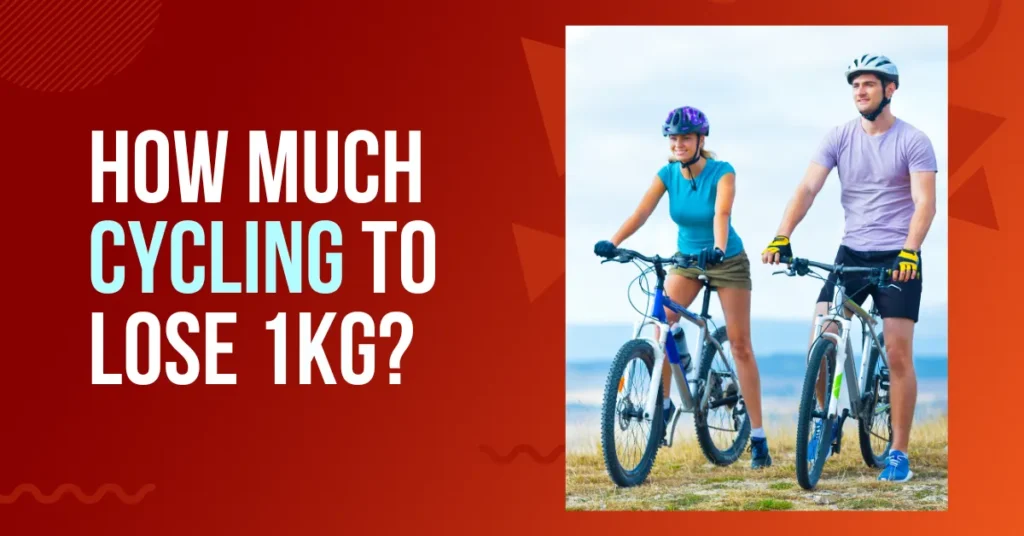
Did you know that cycling is not only a great way to stay fit and enjoy the outdoors, but it can also help in shedding those extra pounds?
In fact, the amount of cycling required to lose 1kg of body weight might surprise you.
Cycling is not only a fun and environmentally friendly mode of transportation, but it can also be an effective way to shed those extra pounds.
According to a study published in the International Journal of Obesity, regular cycling can contribute to significant weight loss and improved body composition. So, if you’re looking to lose weight and enjoy the outdoors, cycling might just be the perfect activity for you.
In this article, we will explore how much cycling is needed to lose 1kg of weight and discuss the factors involved in this process.
Understanding Weight Loss
Before diving into the specifics of cycling for weight loss, it’s important to understand the fundamentals of weight loss itself.
Weight loss occurs when you create a calorie deficit, meaning you consume fewer calories than your body needs to maintain its current weight. When this deficit is created, your body starts utilizing its stored fat as an energy source, leading to weight loss over time.
Several factors influence weight loss, including genetics, metabolism, diet, and physical activity levels. While cycling can contribute significantly to your overall weight loss journey, it’s essential to adopt a holistic approach that includes a balanced diet and other forms of exercise.
Cycling for Weight Loss
Cycling offers numerous benefits for individuals looking to shed excess weight. It is a low-impact cardiovascular exercise that engages various muscle groups, making it an effective way to burn calories and improve overall fitness.
Additionally, cycling is a convenient and accessible activity that can be incorporated into daily routines.
When it comes to weight loss, cycling can be particularly effective due to its ability to elevate your heart rate and increase calorie expenditure. The number of calories burned during cycling depends on factors such as duration, intensity, terrain, and the individual’s weight. On average, cycling can burn anywhere from 400 to 1000 calories per hour, depending on these factors.
How Much Cycling to Lose 1kg in a Month?
On average, to lose 1kg of weight through cycling in a month, you would need to create a calorie deficit of approximately 7700 calories. This can be achieved by cycling consistently for about 11 to 12 hours throughout the month, assuming an average calorie burn of 500 calories per hour. Remember to also maintain a balanced diet for effective weight loss.
Determining Caloric Expenditure
To understand how much cycling is needed to lose 1kg of weight, it’s important to consider the concept of caloric expenditure. Caloric expenditure refers to the number of calories burned during physical activity, including cycling. Several factors influence the caloric expenditure during cycling, including:
- Body weight: Heavier individuals tend to burn more calories due to the increased effort required to move their bodies.
- Intensity: Higher intensity cycling, such as cycling uphill or at a faster pace, leads to a greater calorie burn.
- Duration: Longer cycling sessions result in higher overall calorie expenditure.
- Terrain: Cycling on hilly terrains or rough surfaces can increase energy expenditure.
Calculating the precise number of calories burned during cycling can be challenging, as it depends on individual factors and variables.
However, there are online calculators and fitness trackers available that can provide estimates based on your weight, duration, and intensity of cycling.
Cycling to Lose 1kg

Losing 1kg of weight requires creating a calorie deficit of approximately 7700 calories, as 1kg of fat is roughly equivalent to 7700 calories. To achieve this calorie deficit through cycling, you need to consider the number of calories burned during each cycling session.
Assuming an average calorie burn of 500 calories per hour of cycling, you would need to cycle for approximately 15.4 hours to reach a calorie deficit of 7700 calories. This estimate is based on the assumption that you maintain a consistent intensity and don’t compensate for the calories burned by consuming additional food.
In practical terms, it may not be realistic or feasible to rely solely on cycling to achieve a 1kg weight loss. Therefore, it’s important to combine cycling with a healthy, balanced diet to create a sustainable and effective weight loss plan.
Cycling to Lose 10kg or 5kg
If your weight loss goal is larger than 1kg, such as losing 10kg or 5kg, cycling can still be a valuable component of your weight loss strategy. However, it’s important to set realistic expectations and understand that weight loss is a gradual process that requires time and consistency.
When aiming to lose larger amounts of weight, it’s advisable to incorporate other forms of exercise alongside cycling and pay closer attention to your diet. Combining cardiovascular exercises like cycling with strength training can help build lean muscle mass, which increases your metabolism and facilitates weight loss.
To lose 10kg or 5kg, you would need to create a larger calorie deficit. This can be achieved by increasing the duration and frequency of your cycling sessions or incorporating additional physical activities into your routine. Consulting with a fitness professional or a registered dietitian can provide personalized guidance to help you reach your weight loss goals effectively and safely.
Body Weight Chart (50-60kg)
If your weight falls between 50 to 60kg and you cycle for 1 hour at a moderate pace, the following table provides information on the time required to burn 1kg of body weight at different intensity levels, along with the approximate kilometers (or miles) per hour:
| Intensity Level | Calories Burned (per hour) | KM per Hour (approx.) | Miles per Hour (approx.) | Time Taken to Lose 1kg (In hours) |
| Light | 150 | 10 | 6.2 | 47 |
| Moderate | 250 | 14 | 8.7 | 28 |
| High | 350 | 18 | 11.2 | 20 |
See Also: How Long Does It Take To Bike 3 Miles?
The table above presents estimates based on the assumption of cycling consistently at the specified intensity level. Individual variations, such as metabolism and cycling conditions, may influence the actual time required to achieve weight loss.
Body Weight Chart (60-70kg)
If your weight falls between 60 to 70kg and you cycle for 1 hour at a moderate pace, the table below provides an overview of the time required to burn 1kg of body weight at different intensity levels, along with the approximate kilometers (or miles) per hour:
| Intensity Level | Calories Burned (per hour) | Kilometers per Hour (approx.) | Miles per Hour (approx.) | Time Taken to Lose 1kg (In hours) |
| Light | 180 | 12 | 7.5 | 44 |
| Moderate | 280 | 16 | 9.9 | 31 |
| High | 380 | 20 | 12.4 | 21 |
Please note that these figures are estimations, and individual factors such as metabolism, body composition, and cycling efficiency can influence the actual time needed to achieve weight loss goals. Consistency and adherence to a healthy lifestyle are key factors in successful weight management.
Body Weight Chart (70-90kg)
For individuals weighing between 70 to 90kg, engaging in cycling at a moderate pace for 1 hour can yield the following results in terms of the time needed to burn 1kg of body weight at different intensity levels, along with the approximate kilometers (or miles) per hour:
| Intensity Level | Calories Burned (per hour) | Kilometers per Hour (approx.) | Miles per Hour (approx.) | Time Taken to Lose 1kg (In hours) |
| Light | 220 | 14 | 8.7 | 36 |
| Moderate | 320 | 18 | 11.2 | 25 |
| High | 420 | 22 | 13.7 | 18 |
These figures are approximations and can vary based on individual factors, such as fitness level and cycling proficiency. It’s important to maintain a consistent exercise routine and consider other aspects of a healthy lifestyle for optimal weight loss outcomes.
Body Weight Chart (90-100kg)
For individuals weighing between 90 to 100kg and above, engaging in cycling at a moderate pace for 1 hour can lead to the following estimates regarding the time needed to burn 1kg of body weight at different intensity levels, along with the approximate kilometers (or miles) per hour:
| Intensity Level | Calories Burned (per hour) | Kilometers per Hour (approx.) | Miles per Hour (approx.) | Time Taken to Lose 1kg (In hours) |
| Light | 250 | 16 | 9.9 | 38 |
| Moderate | 350 | 20 | 12.4 | 29 |
| High | 450 | 24 | 14.9 | 17 |
These values serve as general references and should be adjusted based on individual factors and goals. Remember to consult with a healthcare professional or certified trainer for personalized advice to ensure safe and effective weight management.
Other Factors to Consider
While cycling can be an excellent tool for weight loss, it’s crucial to remember that it’s not the sole determinant of your success. Here are a few additional factors to consider when using cycling as part of your weight loss journey:
- Diet and nutrition: To maximize your weight loss efforts, it’s important to adopt a balanced diet that focuses on whole foods, adequate protein intake, and portion control.
- Combining with strength training: Incorporating strength training exercises alongside cycling can help build muscle, boost metabolism, and improve body composition.
- Consistency and sustainability: Consistency is key when it comes to weight loss. Aim to make cycling a regular part of your routine and find a balance that is sustainable in the long run.
- Other physical activities: While cycling can be enjoyable, incorporating other forms of physical activity can add variety and help prevent boredom or plateaus in your weight loss journey.
Conclusion
Cycling can be an effective and enjoyable way to contribute to your weight loss efforts.
By creating a calorie deficit through cycling and adopting a holistic approach that includes a balanced diet and other forms of exercise, you can achieve your weight loss goals.
Remember to set realistic expectations, consult professionals if needed, and prioritize sustainability in your approach to achieve long-term success.
FAQ
How far do you need to ride to lose 1kg of fat?
The distance you need to ride to lose 1kg of fat depends on various factors such as your weight, intensity of cycling, and overall calorie intake. On average, cycling approximately 800-900 kilometers can help create a calorie deficit to lose 1kg of fat.
How much should I cycle a day to lose weight?
To lose weight through cycling, it is recommended to aim for at least 30 minutes to 1 hour of moderate-intensity cycling most days of the week. Gradually increase the duration and intensity as your fitness improves for better results.
Can I lose 10 kg in a month by cycling?
Losing 10kg in a month solely through cycling may not be realistic or healthy. Safe and sustainable weight loss is typically around 0.5kg to 1kg per week. Combine regular cycling with a balanced diet and other exercises for gradual and sustainable weight loss.
Is 10 km cycling enough for weight loss?
Cycling 10 km can contribute to weight loss, but the calorie burn varies depending on factors like intensity and individual metabolism. For effective weight loss, combine cycling with a balanced diet and other forms of exercise to create a calorie deficit.
How many km should I cycle a day to lose 1 kg?
The number of kilometers needed to cycle to lose 1kg depends on factors such as intensity, terrain, and individual characteristics. On average, cycling around 80-100 kilometers can help create the calorie deficit required to lose 1kg.
Is 20 km cycling daily good?
Cycling 20 km daily can be beneficial for overall health and fitness. It contributes to calorie burning, cardiovascular health, and improved endurance. However, the effectiveness for weight loss depends on various factors, including intensity, duration, and diet. It’s important to maintain a balanced approach for sustainable results.






